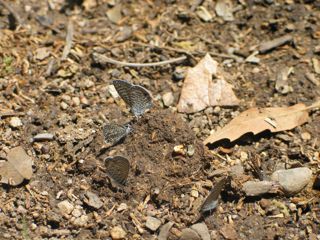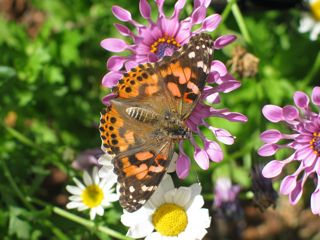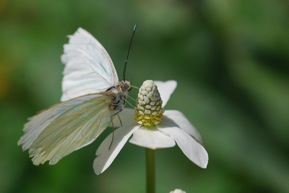I often get questions about how to raise caterpillars. One of my first jobs during college was raising caterpillars, which lead to similar jobs throughout the years. Why raise a caterpillar? Not only does successfully taking care of another living thing lead to insights into its biology and behavior, but also when a beautiful butterfly or moth emerges, it is an amazing experience.
A few weeks ago I wrote a post about white-lined sphinx moth caterpillars.

In the update I mentioned that I had placed a caterpillar in a terrarium with moist potting soil (about five inches deep). The caterpillar immediately disappeared, but I knew where it had gone. Large moth caterpillars, like white-lined sphinx moth caterpillars or tomato hornworms, dig into the soil before pupating. Their pupa looks like a dark reddish-brown cigar. Saturday I found the moth sitting on the cloth I had used to cover the terrarium. It had successfully emerged.
Here it is.


Because white-lined sphinx moths are big and active, they need a lot of nectar to keep them going. After taking a few pictures, I immediately let it go. Here’s a link with some amazing pictures of white-lined sphinx moths. This entire website is full of great information and photographs.
What do you need to raise caterpillars? It does depend on what kind, but here are some general guidelines.
1. Unless you are using a kit that supplies special food, you will need large quantities of fresh plants. And not just any plant, most caterpillars will only take one or a few kinds of plants as food. Once a tiny larva has started eating one kind of plant, they often will refuse to take anything else, even if other members of its species will. A good rule of thumb is only bring home caterpillars that you are absolutely sure you know what they eat, and you have lots of those plants available to feed them. Edit: What white-lined sphinx moth caterpillars eat.
2. Provide a clean, safe container covered with screen or cloth to allow for air circulation. It is best to keep the container outside in as natural conditions as possible. Insect life cycles are extremely sensitive to light and temperature. If you bring the critter inside where it is cool and dark, it may emerge days or even weeks after wild members of its kind and may miss critical windows of opportunity to perform necessary behaviors like mate or migrate.
3. Keep only one or a few in a container. Crowding insects into small containers greatly increases the chances for disease. Insects can get viruses, bacteria and fungi, which can make them sick, just like those things can make humans sick.
Scientists have suggested that monarch butterflies may migrate because of a parasitic infection. This parasite (a protozoan) causes the butterfly to be weak but not die. By going on long migrations, the sick individuals are left behind. When we handle monarchs, we risk spreading the disease even more. Let me know if you’d like more information about this.
4. Provide sticks for butterfly caterpillars to climb on when they are about to make their chrysalises. Moth caterpillars will need plenty of moist soil to dig into. Other caterpillars may like to have different substrates to pupate in, like cloth or egg cartons.
5. Insects are also sensitive to humidity, especially when they are molting. It can be tricky, but try to keep the humidity up without getting the container too moist. Too much humidity can cause things to get moldy.
I hope these guidelines doesn’t sound too negative. Having a lot of experience, I have a better idea of all the things that can go wrong and I wanted you to avoid the problems. And oh yes here’s one more: don’t leave the lid off the container once the caterpillars have pupated. My son did this, and we had cabbage-looper moths all over the house. (It was actually a hoot!)
One great way to raise caterpillars is to plant butterfly and moth plants in a butterfly garden. (Check out an earlier post on butterfly gardening.) Then the caterpillars do all the work themselves.
Also, don’t forget to take a look at some of the butterfly and caterpillars books for children.
And finally, my friend Debbie called again. Her passion vine plants now have gulf fritillary caterpillars on them (see last week’s post for details).










